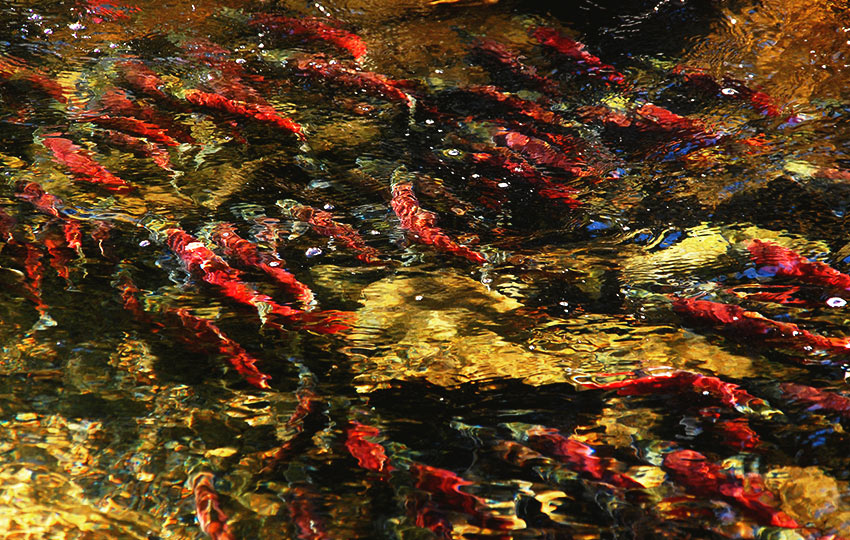
Don’t get me wrong. I have absolutely no problem with Lake Tahoe’s scenery during the fall. The views are as idyllic as any mountainous locale in the world. Really, I’m not complaining. It’s just that I have this one minor, teeny-weeny, itsy-bitsy gripe. And this is coming from an artist, mind you, so take it with a grain of salt. There’s always one small element missing from Lake Tahoe’s autumn landscape, and that’s the color RED.
Sure, some Sierra Nevada flora does transform into a burnt orange or rust color. And, there are even a few leaved bushes that yield a reddish hue. However, there’s nothing as brilliant as the deciduous forests of my youth growing up in the upper Midwest.
***Please note that there isn’t a 2024 Kokanee Salmon Festival aka Fish Fest due to the Taylor Tallac Aquatic Invasive Species Removal project. This project has been in the works since 2021, and is coming to a completion in October (2024). Essentially, mats were placed along 17 acres of Taylor Creek to disrupt the spread of invasive plant species. That’s so far been a success, but now they have to remove the mats (which they’re currently doing). The Forest Service has said that once the mats are removed (which could take weeks), they’ll consider releasing water from Fallen Leaf Lake. And this could trigger the Kokanee Salmon to start spawning. Again, however, this mat removal process will most likely take multiple weeks.
Support Tahoe Trail Guide with a financial contribution via PayPal (single contribution) or Patreon (reoccurring contributions). Your support of Tahoe Trail Guide is very much appreciated!

I realize that I no longer live in the Midwest. However, I’m an artist and am fond of seeing the full spectrum of colors in nature during the fall. There’s something definitive about witnessing a green leaf turn red marking the passage of time and signaling the shift from one season to the next.
An Artistic Calling, Literally
I finally found some “red leaves” in 2012. Apparently, one or two local artists slated for a community-based art project failed to make good on their commitment.
My name was passed from one person to another as a backup to a backup for the project. Or, so the story goes. I don’t recall the details of how it all manifested. The bottom line is that I inherited the project of decorating a resin-cast sculpture of a Kokanee Salmon.
The overall concept was to celebrate the Kokanee Salmon and their fall spawning season. Multiple artists were selected to decorate multiple sculptures. Once completed, the fish would then be displayed at prominent locations around South Lake Tahoe. When I inherited the project, I had about a week to complete the thing. And, I knew nothing about Kokanee Salmon at the time.
More important than the project details, however, are the lessons I learned while researching Kokanee Salmon.
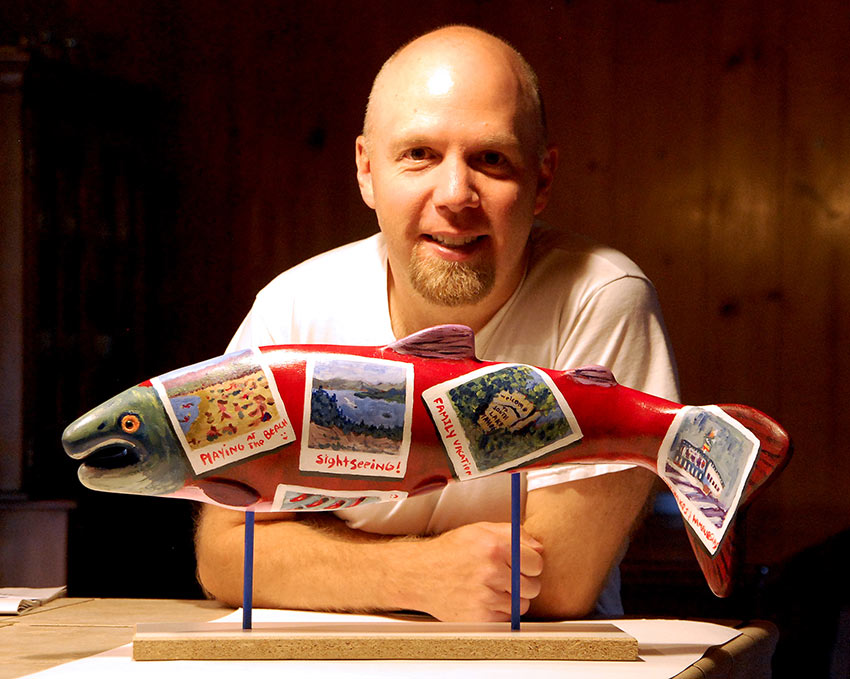
Very Brief History of Kokanee Salmon
Kokanee Salmon were anthropogenically (i.e. introduced by human) added to Lake Tahoe in the 1940s. Specifically, they were stocked at Taylor Creek. People believed they would make for great sport fishing.
Each October the Kokanee Salmon return to Taylor Creek. This is because, as juveniles (aka fingerlings), the scent of Taylor Creek was imprinted on their senses.
Once a rush of cold water from the creek (usually brought on by fall rains or the release of water from Fallen Leaf Lake) flows into Lake Tahoe carrying the creek’s scent, many Kokanee Salmon between the ages of 2-4 years old return to spawn.
At Taylor Creek, they procreate and subsequently die.
As part of the spawning process, Kokanee Salmon turn a bright red color in order to attract a mate. And I mean bright! Every visitor to Lake Tahoe during the fall should witness this sight at least once.
Taylor Creek is located on the south shore of Lake Tahoe, just south of Emerald Bay. See the map at the bottom of article to locate Taylor Creek.
Physical Characteristics of Kokanee Salmon
The sexual preference of the Kokanee (for the color red) has been passed down from Sockeye Salmon. This is because Sockeye Salmon are of the same evolutionary branch.
Sockeye Salmon swim to the ocean and eat species that contain carotenoid pigments enabling them to turn red. On the other hand, Kokanee Salmon are land-locked and have adapted by processing the pigments far more efficiently.
There’s simply less food in freshwater that contains carotenoid pigments. But Kokanee Salmon preference for the color red has remained, hence their adaptation.
In addition to transforming from their natural silver-blue color to red, males develop a green head and fins. They also have a hump back, a protruding jaw, and big teeth.
This Mr. Hyde-like appearance can be a bit startling and their intense red color is arresting. These transformative characteristics enable them to intimidate other male Kokanee. This provides them (the ones doing the intimidating) the greatest chances of mating.

Brief Overview of the Kokanee Salmon Life Cycle
The Kokanee make their way up Taylor Creek. And, a female, having selected a mate, begins to make her nesting area called a redd. She creates this redd by swimming in circles and swishing her tail around a specific area. This leads to the formation of a 4-6 inch pocket in the bed of the creek.
Once completed, she deposits her eggs and moves. Then, her selected mate fertilizes the eggs and guards the site. The female can lay eggs in multiple redds depositing between 400-1200 in total. However, each male remains at their respective site.
Only a tiny fraction of the total eggs will end up surviving despite the males’ best efforts to protect them. Within a few days of laying the eggs the female will die, followed shortly thereafter by the males. Although, the males sometimes survive for up to two weeks following the fertilization process.
It takes approximately 3-5 months for the surviving eggs to hatch. At that point they’ll lie in wait beneath the gravel for another couple of weeks developing the ability to feed themselves.
They then emerge from their hiding places as baby fish called fry. For another month they’ll hang out and eat, gaining the necessary size and strength for their journey to Lake Tahoe.
During this transformation from fry to fingerling, they gain their sense of place in Taylor Creek. Mostly, this involves learning Taylor Creek’s distinct scent. As fingerlings, the Kokanee swim to Lake Tahoe and live for 2-4 years. They’ll eventually return and continue their cycle of birth and death in Taylor Creek.
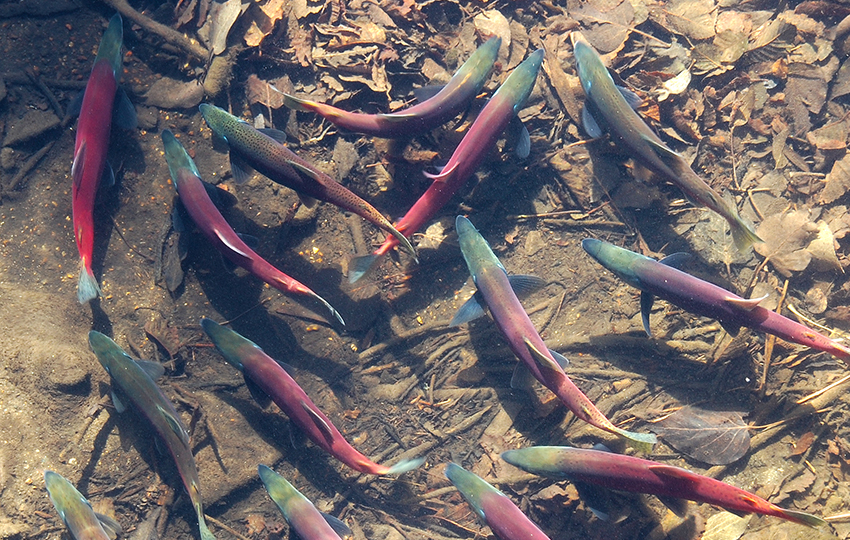
Challenges That Kokanee Salmon Face
The tale of the Kokanee Salmon is a grand one providing a microcosmic look at the macrocosmic world.
What I find most fascinating is that, inherent within their story, is one very problematic element. And it’s the same that we all face which, is to say, that we live in a finite space.
Taylor Creek is barely two miles long. The creek is limited in size, so it’s also limited in resources. And, it’s constantly at the mercy of nature.
Many predators in the vicinity know of this place. Gulls and water fowl such as Mergansers will actually eat the whole adult fish. Mallards, on the other hand (and other fish and critters) will seek out their eggs.
Once the Kokanee spawn and die, their rotting carcasses scent the air. You’ll often observe scavenging critters such as Raccoon and Coyote arrive for this feast.
Black Bears are mostly vegetarian. However, they’ll still wind up congregating around the banks of Taylor Creek to eat the fish carcasses.
For that last reason, it’s not uncommon for the Forest Service to close off the upper portion of Taylor Creek to visitors. That’s because, over the years, tourists and wildlife photographers have swarmed Taylor Creek as much for the Black Bears as the Kokanee. And this has created a negative situation for the bears because they get too habituated around people.
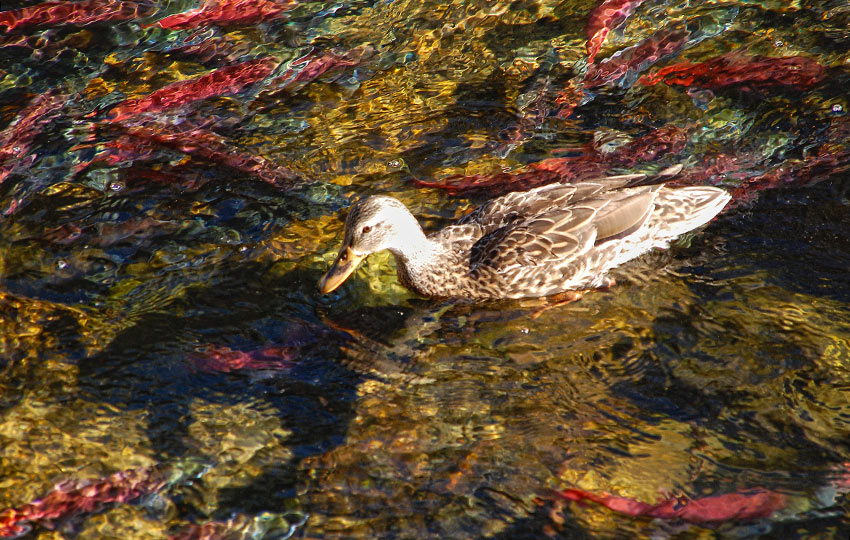
Additional Challenges of the Kokanee Salmon
Other problematic factors for the Kokanee Salmon that are directly related to the small size of Taylor Creek are:
- Drought conditions
- Excessively wet conditions
- Presence of Beaver dams.
Kokanee are slow to spawn during years where there’s little rain to fill Taylor Creek. Or, if the Forest Service doesn’t release water from Fallen Leaf Lake. Remember, the Kokanee need that cold rush of water to carry its scent into Lake Tahoe.
Even when traveling upstream, they face limited water in which to swim and lay eggs. Also consider the fact that a lack of water results in a lack of oxygen. This adversely affects the development of the eggs.
Too much water introduced into Taylor Creek at one time can cause other problems. The introduction of too much water may be due to flooding conditions, for example. Essentially, the massive increase in water (in a short time) can wash the eggs downstream. This either will destroy them or simply leave them unprotected.
Beaver dams are not inherently bad things. However, at Taylor Creek they stem the flow of water and limit the already finite real estate where Kokanee spawn. In response to this situation, Forest Service personnel will often cut notches into the dams. This allows water to flow more freely down the creek. On paper it’s a great idea, but in practice it’s challenging. Too small of a notch has no effect. Too big of a notch floods the creek. Again, this can wash the eggs away. But it also causes additional erosion to the banks of the creek depositing excessive amounts of sediment into Lake Tahoe. And, if the notch is cut just right (in a bad way, that is), it’ll become a fire hose. This jet stream of water shooting out of the notch creates such a stiff current that the fish become too exhausted to carry on.
The Forest Service aids Kokanee Salmon in another way by placing fingerlings elsewhere at Lake Tahoe. They’ll place fingerlings in the middle of the lake as well as other mountain lakes. This can cause the fish to (hopefully) find another location in which to spawn each fall. This approach has yielded some success as evidenced by sightings of Kokanee spawning in the Truckee River.
Kokanee Salmon Festival
During the first week of October, the Forest service holds an annual celebration of the Kokanee Salmon spawning season. This event is called the Kokanee Salmon Festival.
Specifically, the event is located at the Taylor Creek Visitor Center. The center is a satellite location of the Forest Service’s Lake Tahoe Basin Management Unit. Here there are tours and a gift shop.
It’s worth taking the family to in order to learn more about this cool species of fish.
Please note that in 2024, there wasn’t a Fish Fest due to the Taylor Creek Invasive Species Project, which was nearing completion at the beginning of October (2024). This project involved placing protective mats on 17 acres of Taylor Creek in an effort to inhibit invasive species from growing. It was a success, but it disrupted the Kokanee Salmon run because the team spent most of October removing the mats.
Final Thoughts About Kokanee Salmon
The Kokanee Salmon are a non-native species to Lake Tahoe. And, clearly they require some management in which to enable their survival. So one of my questions was, “Why bother trying to protect and save them?”
The fact is that they’re not an invasive species. Kokanee Salmon aren’t taking over the place. For reasons beyond their control, Kokanee Salmon are a part of the Lake Tahoe ecosystem. And, they’re simply trying to survive.
In many respects, they do actually contribute to the overall health (ecologically and economically) of the Lake Tahoe Basin. They provide food for many native species. And, they’re also an attraction related to outdoor recreation in the form of sport fishing and sightseeing.
I might also add that they add a little red color to the landscape during the fall at Lake Tahoe.
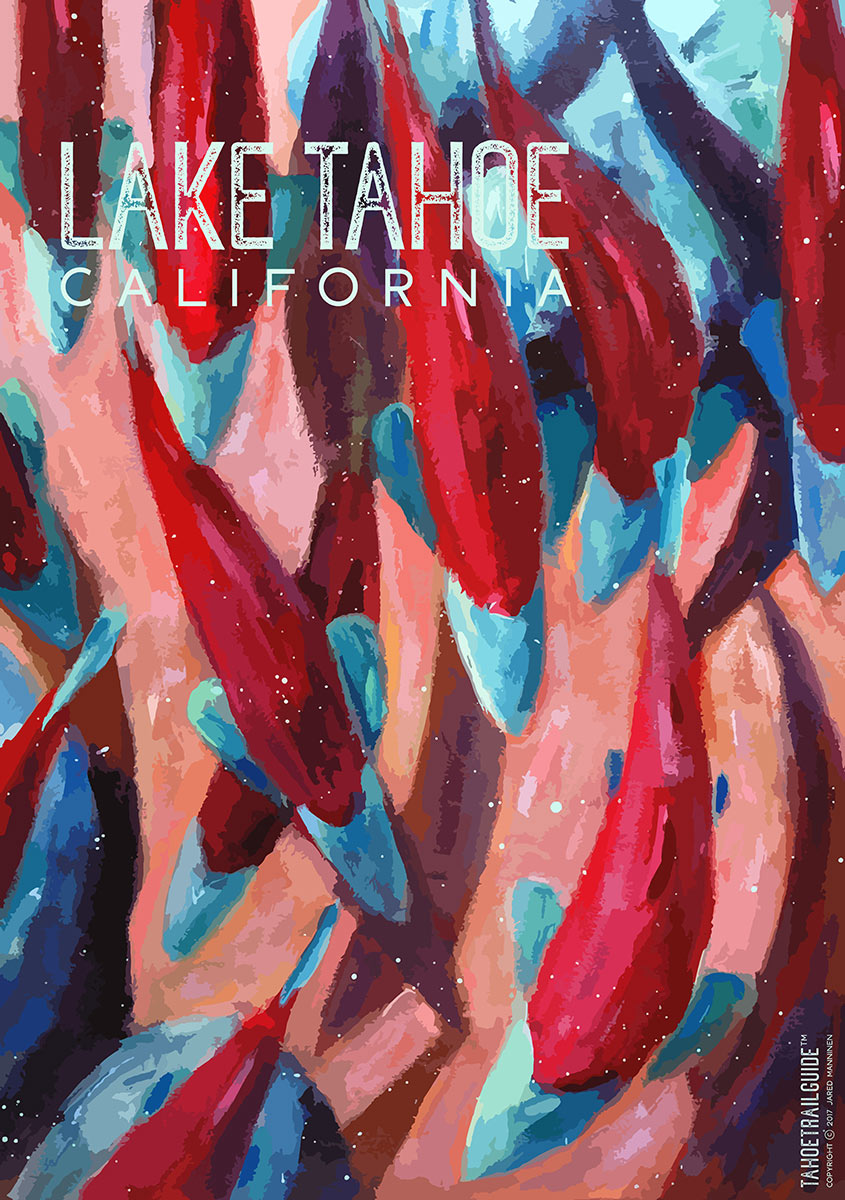
Articles About Lake Tahoe Plants and Wildlife
The following Tahoe Trail Guide articles feature information, history, and stories about the various forms of plant and wildlife that you can find at Lake Tahoe.
Lake Tahoe Wildflowers
- Two Major Factors that Determine Peak Bloom Times for Wildflowers at Tahoe
- Tips for Finding Wildflowers at Tahoe
- The Sinister Mustard Flower Rust
- Big Yellow Wildflowers with Big Green Leaves called Woolly Mule’s Ears and Arrowleaf Balsamroot
Trees of the Sierra Nevada
Birds of Lake Tahoe
- The Tree Cleaving Pileated Woodpecker
- How Woodpecker Contribute to Healthy Forests at Lake Tahoe (and other fun facts)
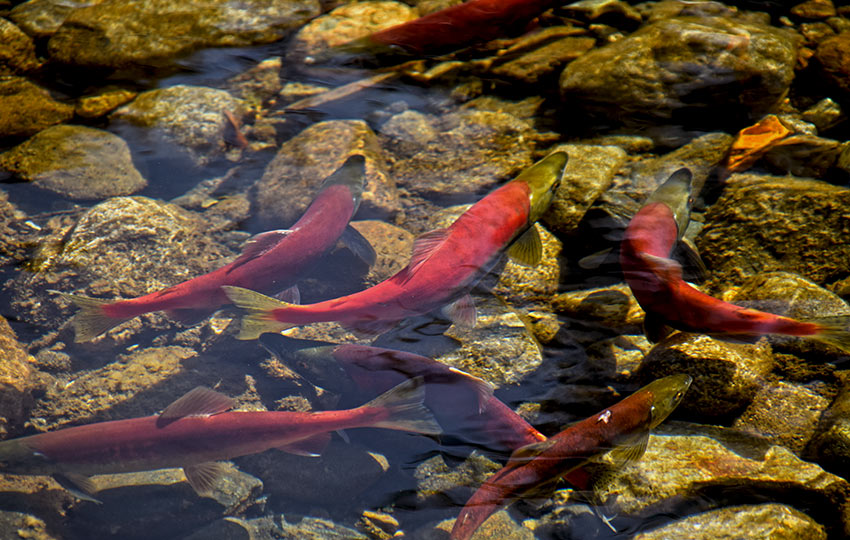
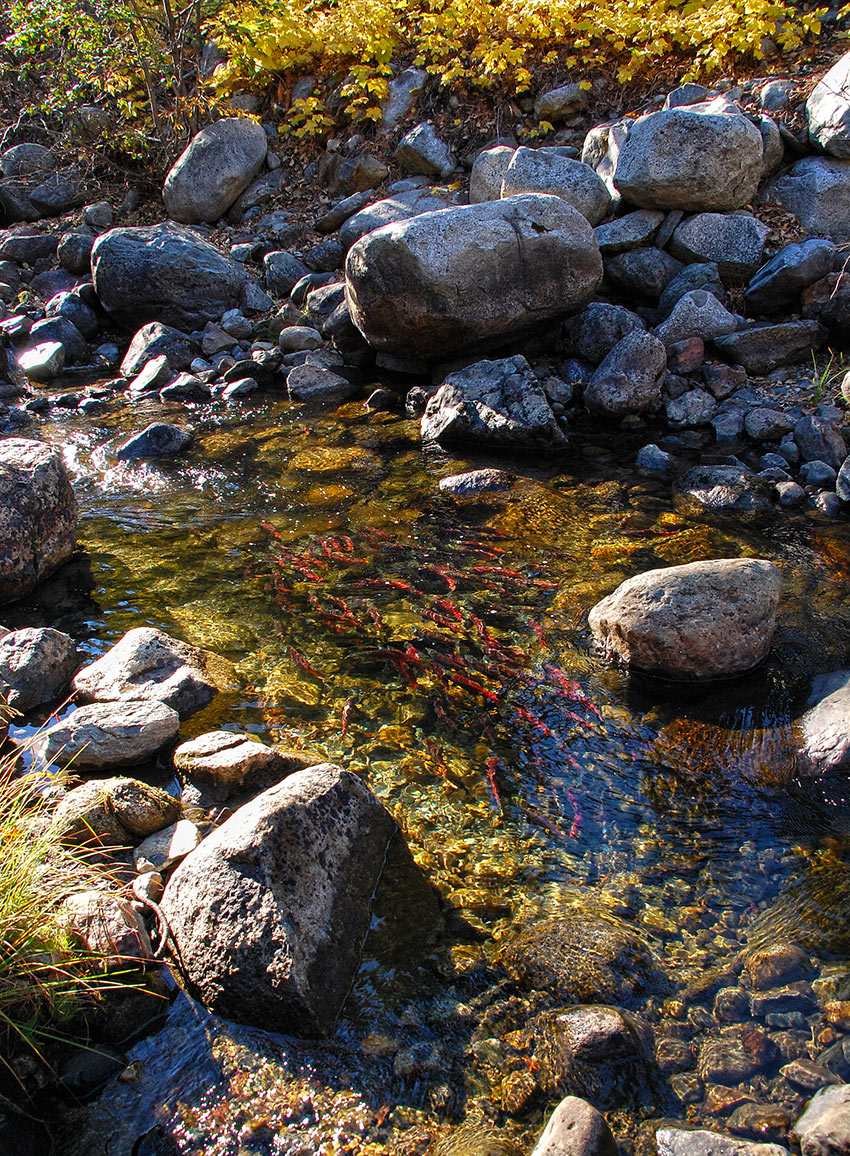
In the early 80’s I would come up from Berkeley with a car full of kids, overpopulate a cute cabin, and head to a visitor center that had an underground path walk walled by spewing salmon. Does it still exist?
Hey Dorje,
Yes, you’re talking about the Taylor Creek Visitor Center. And the underground path is for the Stream Profile Chamber. Both of those still exist, but they’re closed for the season (as of last week). The Kokanee Salmon didn’t run quite as strong this fall because the Forest Service didn’t let out any water from Fallen Leaf Lake because there were workers removing a bunch of mats (used to inhibit the growth of invasive plant species) from Taylor Creek all fall. The mat removal was from a multi-year project designed to stem the growth of those invasive species. And, from what I understand, it was effective.
Thanks for reading, and for commenting. I appreciate it 🙂
We came here in 2019 and it was crowded but for the most part everyone behaved. Maybe Covid had them behaving badly.
Hey Lisa,
It was definitely busier last year (2020) compared to every other summer that I’ve lived here (15+ years). That said, at Taylor Creek in recent years so many people have been getting too close to the Black Bears that tend to feed on the Kokanee carcasses. They have been trying to get selfies and other photographs of the bears, so the FS has been pretty quick to close of sections of Taylor Creek to protect the bears. And then with Covid, I think the FS just decided to close it all off to discourage people congregating.